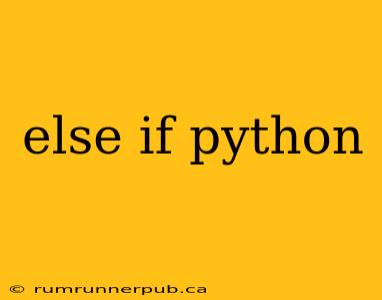Python's elif statement is a crucial tool for building robust and flexible programs. It allows you to create a chain of conditional checks, executing only the first condition that evaluates to True. Understanding its nuances is vital for any Python programmer. This article will delve into elif, clarifying its functionality and demonstrating its use through examples and insights gleaned from Stack Overflow discussions.
Understanding elif
The elif (short for "else if") statement is used within an if-else structure. It provides a way to test multiple conditions sequentially. Only the block of code associated with the first condition that evaluates to True will be executed. If none of the conditions are true, the code within the optional else block (if present) is executed.
Basic Syntax:
if condition1:
# Code to execute if condition1 is True
elif condition2:
# Code to execute if condition1 is False and condition2 is True
elif condition3:
# Code to execute if condition1 and condition2 are False and condition3 is True
else:
# Code to execute if none of the above conditions are True
Example:
Let's say we want to assign a letter grade based on a student's score:
score = 85
if score >= 90:
grade = "A"
elif score >= 80:
grade = "B"
elif score >= 70:
grade = "C"
elif score >= 60:
grade = "D"
else:
grade = "F"
print(f"The student's grade is: {grade}") # Output: The student's grade is: B
This example clearly demonstrates the sequential nature of elif. The code checks the conditions in order. Once a True condition is found, the corresponding code block executes, and the rest of the elif and else blocks are skipped.
Addressing Common Stack Overflow Questions
Many Stack Overflow questions revolve around the correct usage and potential pitfalls of elif. Let's address some of these:
1. Nested if-elif-else Structures:
Sometimes, you might need more complex conditional logic. Nested if-elif-else structures are possible, but they can become difficult to read and maintain if they're too deeply nested. Consider refactoring to simpler structures or using dictionaries for more complex scenarios. (Inspired by numerous Stack Overflow discussions about code readability and maintainability).
Example of Nested elif (Use Sparingly!):
age = 25
country = "USA"
if age >= 18:
if country == "USA":
print("You can vote in the USA.")
elif country == "Canada":
print("You can vote in Canada.")
else:
print("Voting eligibility depends on your country.")
else:
print("You are not yet eligible to vote.")
2. elif vs. Multiple if Statements:
While you could use multiple independent if statements, using elif is generally preferred when the conditions are mutually exclusive (only one can be true at a time). elif improves readability and efficiency by avoiding unnecessary checks once a condition is met. (This point is frequently discussed in Stack Overflow threads comparing if and elif performance and style).
3. Handling Complex Conditions:
For very complex conditions, it's often better to break them down into smaller, more manageable parts. This increases readability and makes debugging easier. Consider using helper functions to encapsulate complex logic. (A recurring theme in Stack Overflow's best-practice advice).
Beyond the Basics: Practical Applications
elif shines in scenarios like:
- Menu-driven programs: Creating interactive programs where user input determines the program flow.
- Game logic: Defining different game states or actions based on player choices or events.
- Data validation: Checking if input data meets specific criteria before processing it.
- Error handling: Handling different types of errors with specific responses.
By mastering the elif statement and understanding its subtleties, you'll be well-equipped to craft more sophisticated and efficient Python programs. Remember to prioritize clear, concise code – a key tenet emphasized repeatedly in Stack Overflow's community guidelines.
